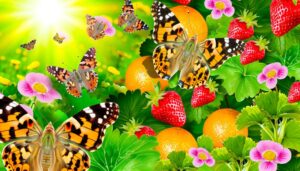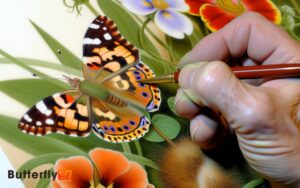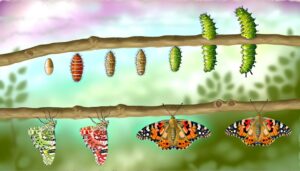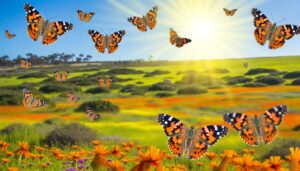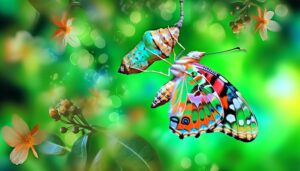Painted Lady Butterfly Amazing Bugs Kit: Discover and Learn!
In addition, The Painted Lady Butterfly Amazing Bugs Kit offers a detailed exploration into butterfly metamorphosis. It includes a magnifying glass, tweezers, specimen jars, and an instruction booklet for practical investigations.
Setting up the habitat involves careful lighting, enclosure assembly, and food station preparation. Key stages to monitor are growth, chrysalis formation, and wing expansion. The kit emphasizes precise daily care and proper nutrition to foster healthy development.
Moreover, it sharpens understanding of life cycles, applying the scientific method to study metamorphosis. The kit also raises awareness about conservation and ecosystems.
Discover the intricate processes and educational rewards this kit provides.
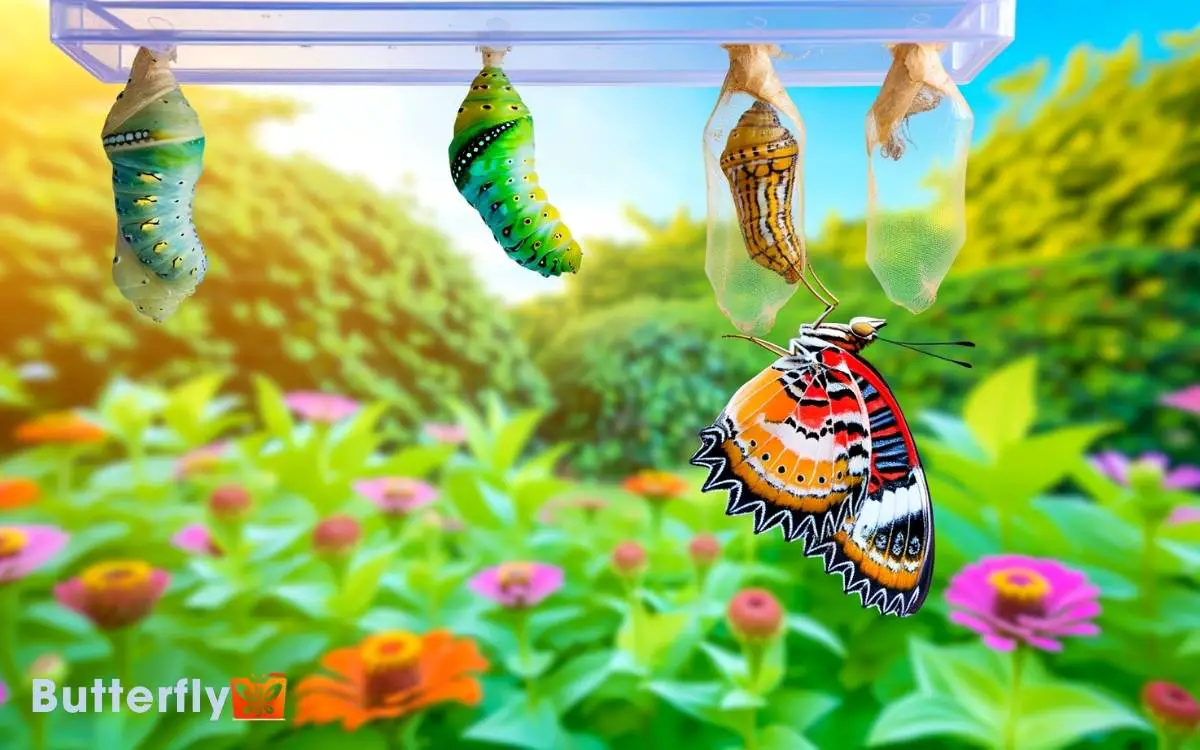
Key Takeaways
Unboxing the Kit
Upon opening the Amazing Bugs Kit, users will find a well-rounded array of tools and specimens designed to facilitate hands-on entomological exploration.
The kit includes a magnifying glass, tweezers, specimen jars, and a detailed instruction booklet. Each tool serves a specific purpose, ensuring users can closely examine the included butterfly larvae and other insects.
The magnifying glass allows for detailed observation of insect morphology, while the tweezers offer precision handling. Specimen jars are provided to temporarily house insects for study.
The instruction booklet, rich with diagrams and explanations, guides users through the various stages of insect life cycles and proper handling techniques.
This set enables a thorough and engaging exploration of entomology for enthusiasts of all levels.
Setting Up the Habitat
Setting up the habitat involves carefully assembling the provided components to create an environment that mimics the natural conditions essential for the insects’ survival and growth.
- First, select a stable, well-lit location away from direct sunlight and drafts.
- Next, construct the enclosure using the mesh netting and frame, ensuring all connections are secure.
- Then, prepare the food station by mixing the provided nutrient solution and placing it in the designated container.
- Finally, position the artificial twigs and leaves to offer climbing structures and resting spots.
Introducing the Caterpillars
In the ‘Amazing Bugs Kit‘, understanding caterpillar growth stages, habitats, and care is crucial for successful rearing.
The guide outlines the metamorphosis process, emphasizing ideal environmental conditions and specific feeding requirements.
Caterpillar Growth Stages
How do caterpillars transform so remarkably from tiny eggs into intricate butterflies, journeying through distinct and fascinating growth stages? The process, known as metamorphosis, involves several critical phases, each essential for the caterpillar’s development.
- Egg Stage: Female butterflies lay eggs on host plants. These eggs are small, round, and contain the initial stages of life.
- Larval Stage: Upon hatching, the caterpillar, or larva, emerges. During this stage, it eats voraciously, primarily consuming the host plant’s leaves.
- Pupal Stage: After growing sufficiently, the caterpillar forms a chrysalis. Inside, it undergoes significant transformation.
- Adult Stage: Finally, the butterfly emerges, ready to begin the cycle anew.
Each stage is meticulously orchestrated, ensuring survival and eventual transformation into a butterfly.
Habitats and Care
Creating an ideal habitat is crucial for the healthy growth and development of caterpillars, necessitating specific environmental conditions and careful monitoring.
The Painted Lady caterpillars require a well-ventilated enclosure to prevent mold growth and maintain adequate air circulation. The temperature should be maintained between 70-75°F, as extreme temperatures can hinder their development.
Humidity levels should be moderate, around 40-50%, to prevent dehydration or excessive moisture. A substrate, such as paper towel or sterilized soil, should be placed at the bottom of the enclosure to absorb waste and provide a clean environment.
Regularly check for signs of stress or illness, such as lethargy or discoloration, and promptly address any issues to maintain ideal conditions for their metamorphosis.
Feeding Requirements
Once the ideal habitat is established, the next step is guaranteeing the caterpillars receive proper nutrition to support their growth and metamorphosis. Caterpillars require a specific diet to thrive, primarily consisting of nutrient-rich leaves.
Here are four critical feeding requirements for Painted Lady caterpillars:
- Type of Food: Use a commercial caterpillar diet or fresh host plants like thistle or mallow.
- Frequency: Make sure caterpillars have constant access to food; replace leaves daily if using fresh plants.
- Quantity: Provide ample food to accommodate their rapid growth and high metabolic needs.
- Hygiene: Maintain a clean feeding area to prevent mold and bacterial growth, which can harm the caterpillars.
Meeting these feeding needs is essential for healthy development and successful metamorphosis.
Daily Care Routine
A consistent daily care routine is essential for maintaining the energy and health of the bugs in the Amazing Bugs Kit. Each day, caregivers should make sure the habitat is clean by removing any waste and uneaten food.
Maintaining ideal humidity levels is key; lightly misting the habitat with water helps achieve this. Temperature control is also important; the environment should be kept between 70-75°F.
Observing the larvae’s behavior and condition daily can help identify any potential health issues early. Adequate ventilation is necessary to prevent mold growth and ensure proper air circulation.
Watching the Growth Stages
In observing the growth stages, one must first note the shift from egg to caterpillar, a phase that involves significant cellular changes and growth.
The subsequent chrysalis formation process marks a critical period of metamorphosis, where the caterpillar undergoes extensive reorganization into butterfly form.
Egg to Caterpillar
The transformation from egg to caterpillar involves a series of meticulously timed developmental stages that can be fascinating to observe under controlled conditions. Within a few days, the eggs hatch into tiny larvae, beginning on an essential feeding phase.
To understand the process better, consider these stages:
- Egg Laying: Female butterflies deposit eggs on host plants, ensuring larvae have an immediate food source.
- Hatching: Eggs hatch within 3-5 days, releasing larvae.
- Feeding: Newly emerged larvae, or caterpillars, voraciously consume plant material to fuel rapid growth.
- Molting: Caterpillars shed their exoskeletons multiple times, known as instars, each time growing larger.
These stages are essential for the caterpillar’s development before it progresses to the chrysalis stage.
Chrysalis Formation Process
Observing the chrysalis formation process reveals a complex and meticulous metamorphosis from caterpillar to butterfly, marked by significant physiological and structural changes.
Initially, the caterpillar attaches itself to a stable surface using silk. It then sheds its final larval skin, exposing the chrysalis.
Within this protective casing, the organism undergoes histolysis, where larval tissues break down into cellular components, and histogenesis, where these components reorganize into adult structures.
The imaginal discs, undifferentiated cells present since the larval stage, rapidly differentiate into the butterfly’s wings, legs, and antennae. Concurrently, the nervous system, musculature, and digestive tract transform, aligning with the butterfly’s requirements.
This critical phase exemplifies nature’s engineering, emphasizing adaptation and transformation at a microscopic level.
Emerging as Butterfly
Emerging from the chrysalis, the butterfly undergoes a rapid and intricate development process that showcases its metamorphosis from a pupa to a fully-formed adult.
This transformation involves significant physiological changes, each stage critical to the butterfly’s survival. Observing these stages provides valuable insights into entomology and developmental biology.
- Wing Expansion: Upon emergence, the butterfly’s wings are soft and crumpled. It pumps hemolymph into the wing veins to expand and harden them.
- Coloration: As the wings dry, vibrant patterns unique to the species become visible, aiding in identification and mating.
- Behavioral Adaptation: The butterfly exhibits instinctual behaviors such as sunning to warm up and improve flight.
- Feeding: The butterfly begins using its proboscis to feed on nectar, shifting from a larval diet of leaves.
Chrysalis Formation
During chrysalis formation, caterpillars undergo a complex physiological transformation that involves the reorganization of their entire body structure. Initially, the caterpillar attaches itself to a secure surface using silk.
It then undergoes apolysis, where the old cuticle separates from the epidermis. Following this, the caterpillar molts, revealing the chrysalis beneath.
Inside the chrysalis, histolysis breaks down larval tissues, while histogenesis forms adult structures like wings and antennae. Organs such as the heart and tracheal system are also reconfigured to suit the butterfly’s needs.
Hormonal changes, particularly involving ecdysteroids, regulate these processes. The entire transformation is a marvel of developmental biology, showcasing the efficiency and intricacy of metamorphosis in the Painted Lady Butterfly.
Emergence of Butterflies
During the emergence of butterflies, the transformation within the chrysalis involves intricate physiological changes.
Detailed analysis of the butterfly wing development reveals the formation of scales and pigmentation patterns essential for survival.
Upon emergence, the butterfly’s first flight experience is critical as it tests the functionality of its newly developed wings.
Chrysalis Transformation Process
The chrysalis transformation process, a critical stage in a butterfly’s life cycle, involves intricate physiological changes as the caterpillar’s body breaks down and reforms into a butterfly.
This metamorphosis is marked by several key events:
- Histolysis: The caterpillar’s tissues disintegrate into a nutrient-rich soup.
- Histogenesis: Imaginal discs, clusters of undifferentiated cells, develop into adult structures.
- Hormonal Regulation: Ecdysteroids and juvenile hormones coordinate the transformation.
- Cuticle Formation: A protective outer layer forms around the developing butterfly.
These stages facilitate the successful emergence of the butterfly, transforming it from a larval to an adult form. Each phase is meticulously regulated, illustrating nature’s precision in guiding this complex biological process.
Understanding these steps highlights the remarkable adaptability and evolution of butterflies.
Butterfly Wing Development
As the butterfly emerges from the chrysalis, its wings, initially crumpled and wet, rapidly expand and harden through the process of hemolymph pumping and cuticle sclerotization.
Hemolymph, the insect equivalent of blood, is pumped into the wing veins, causing them to inflate and extend. This expansion is vital for the butterfly to achieve its full wing span.
Simultaneously, cuticle sclerotization occurs, where proteins cross-link within the wing membranes, providing structural rigidity and durability.
The entire process takes a few hours, during which the butterfly remains relatively immobile to allow proper wing development.
Without these precise physiological mechanisms, the butterfly would be unable to attain functional wings necessary for survival and mobility in its environment.
First Flight Experience
Once the butterfly’s wings have fully hardened, it prepares for its maiden flight by flexing its muscles and testing its wing movements. This pivotal stage guarantees that the wings are functional and ready for flight.
Observers can note several critical steps in this process:
- Wing Flexing: The butterfly repeatedly opens and closes its wings, strengthening the muscles needed for flight.
- Initial Flaps: Small, rapid wing flaps help test the balance and aerodynamics.
- Proboscis Testing: The butterfly extends and retracts its proboscis, making sure it’s ready for feeding.
- First Takeoff: With a sudden burst, the butterfly launches from its perch, maneuvering through the air currents for the first time.
These steps highlight the complexities involved in the butterfly’s first flight, essential for survival.
Feeding Your Butterflies
To guarantee peak health and longevity, feeding butterflies a nutrient-rich diet is essential. Painted Lady butterflies thrive on a mixture of sugar and water or fruit juice, simulating nectar. Providing fresh slices of fruit, such as oranges or bananas, can further enhance their nutrition and energy levels. Ensuring a proper diet from the early stages is just as important, which is why many enthusiasts look for a painted lady butterfly larvae sale to raise healthy butterflies from caterpillars. By maintaining a suitable habitat and offering the right nutrients, these butterflies can flourish and live out their full lifespan.
A 10% sugar solution is ideal: dissolve one teaspoon of sugar in nine teaspoons of water. Alternatively, provide fresh fruit like oranges or melons.
Place the sugar solution in a shallow dish with a sponge to prevent drowning. Position slices of fruit in the habitat, ensuring easy access.
Cleanliness is vital; replace sugar water and fruit daily to prevent mold and bacterial growth. Nutrient-rich feeding supports their energy needs, aiding in vibrant coloration and active flight, contributing to their overall well-being.
Observing Butterfly Behavior
Butterfly behavior in captivity provides invaluable insights into their natural habits, including feeding patterns, mating rituals, and flight dynamics.
Observing these behaviors offers an analytical perspective critical for understanding their life cycle and ecological interactions.
Key observations include:
- Feeding Patterns: Monitor how frequently butterflies visit nectar sources, noting any preferences for specific flowers or artificial feeders.
- Mating Rituals: Document courtship behaviors such as wing displays and pheromone release, which are essential for successful reproduction.
- Flight Dynamics: Analyze flight paths, wing beats, and rest periods to understand energy expenditure and territorial behavior.
- Social Interactions: Observe interactions among individuals, identifying any hierarchical structures or aggressive encounters.
These observations, systematically recorded, contribute significantly to entomological research and butterfly conservation efforts.
Releasing Into the Wild
Releasing butterflies into the wild involves meticulous planning and consideration of environmental factors to guarantee their successful integration and survival.
First, the best release time must be chosen, ideally a warm, sunny day when temperatures exceed 65°F. This ensures that butterflies are active and can feed immediately.
The release site should be rich in nectar plants, providing essential food sources. It’s important to avoid pesticide-treated areas, as chemicals can be harmful.
Observing local weather patterns is also significant; releasing butterflies before a storm can be detrimental.
Additionally, ensuring the butterflies are fully developed and healthy is crucial for their adaptation to the wild. Proper preparation enhances their chances of thriving in their natural habitat.
Educational Benefits
Understanding the meticulous process of releasing butterflies into the wild not only aids in their survival but also offers substantial educational benefits, particularly in the fields of biology and environmental science.
The Painted Lady Butterfly Amazing Bugs Kit serves as a powerful educational tool that provides:
- Life Cycle Observation: Students can witness the transformation from caterpillar to butterfly, understanding each developmental stage in detail.
- Ecosystem Insight: It highlights the butterfly’s role within ecosystems, fostering a deeper appreciation for biodiversity.
- Scientific Method Application: Learners can conduct experiments, formulate hypotheses, and document observations, reinforcing scientific inquiry skills.
- Conservation Awareness: The kit underscores the importance of conservation efforts, promoting responsible environmental stewardship.
Conclusion
Ironically, while the Painted Lady Butterfly Kit claims to be an ‘amazing’ educational tool, it’s fascinating how it ends up teaching more about patience than entomology.
As each stage unfolds from habitat setup to the final release one can’t help but marvel at the intricacies of nature and its impeccable timing.
Ultimately, while the butterflies gain their freedom, the true metamorphosis happens within the observers, who emerge more knowledgeable and surprisingly, more patient.


